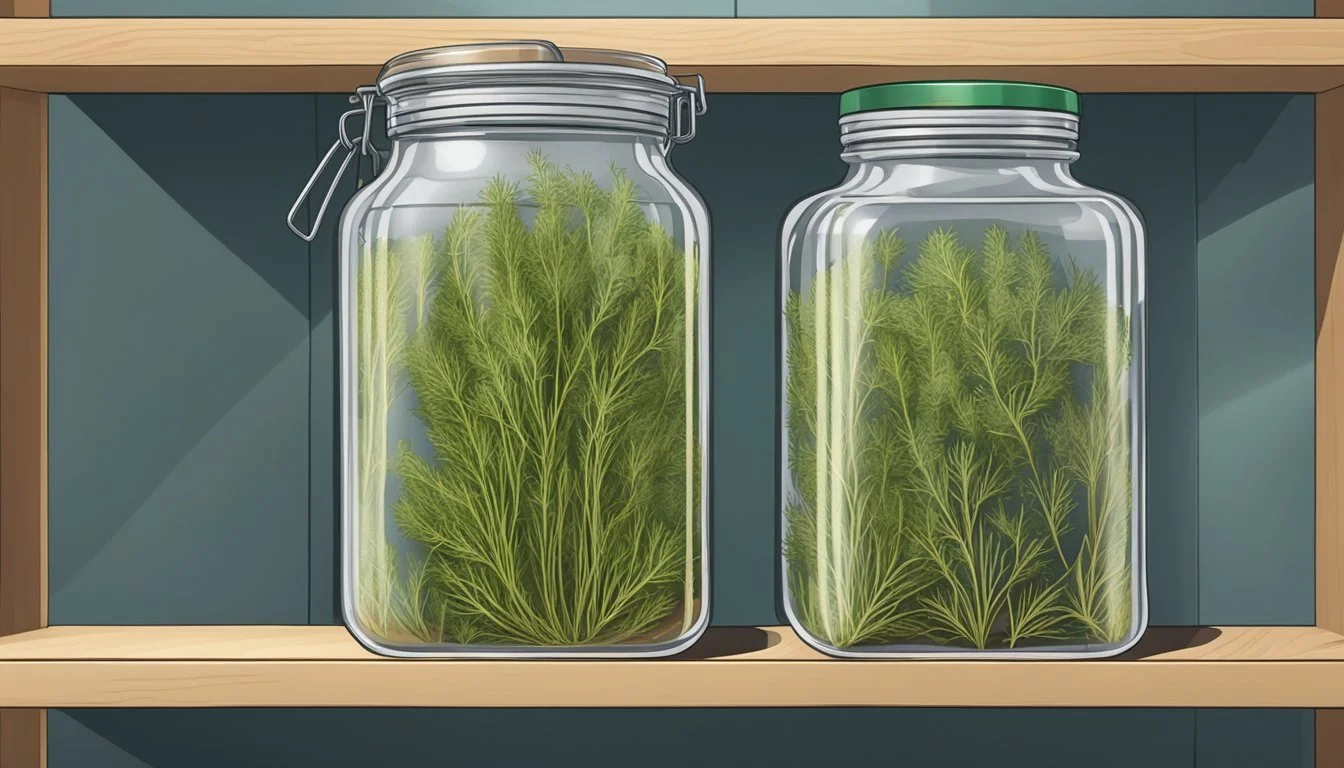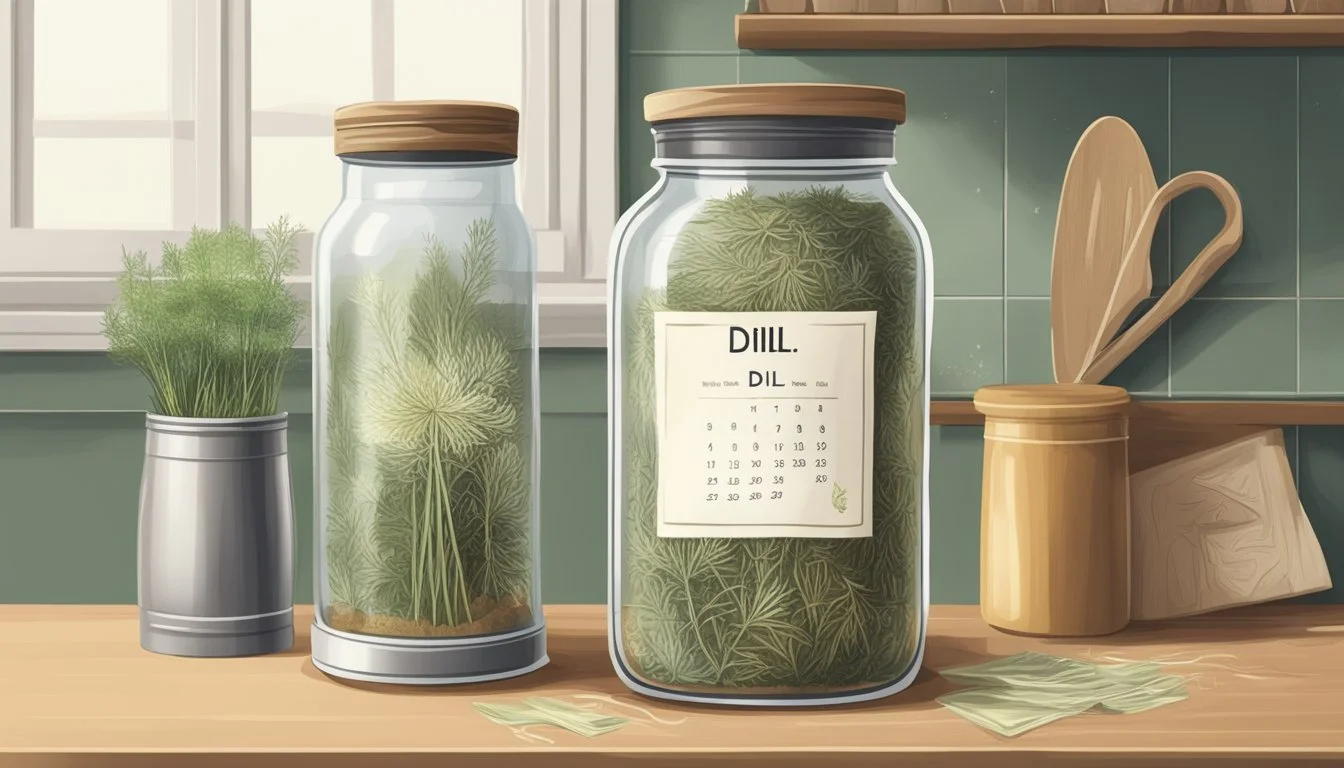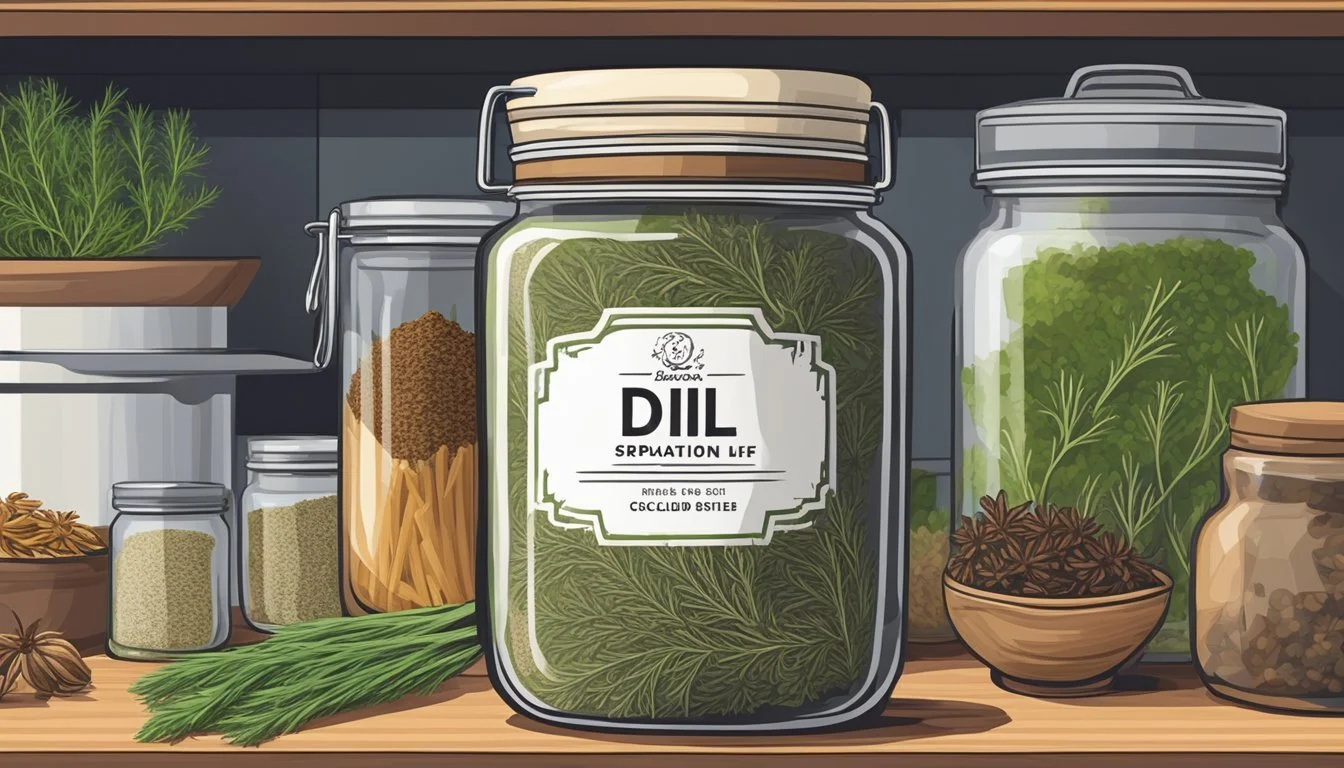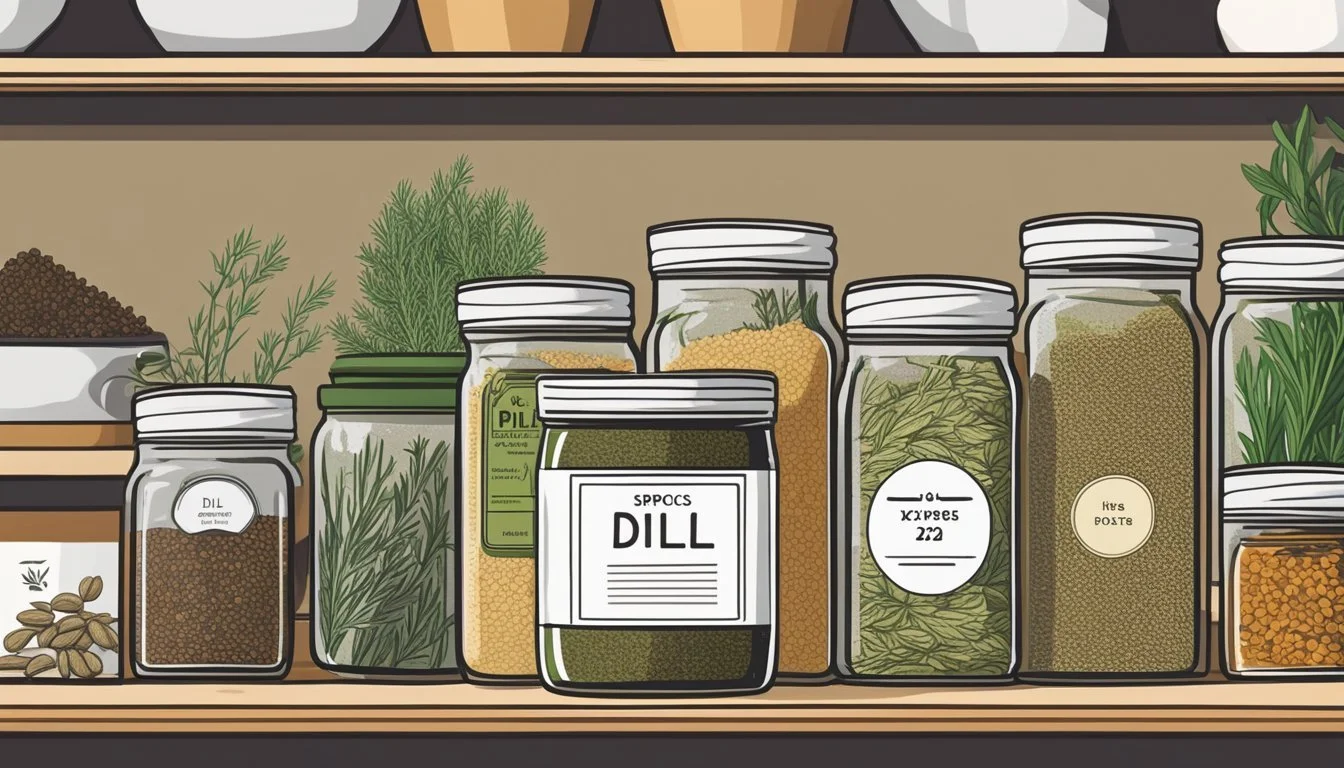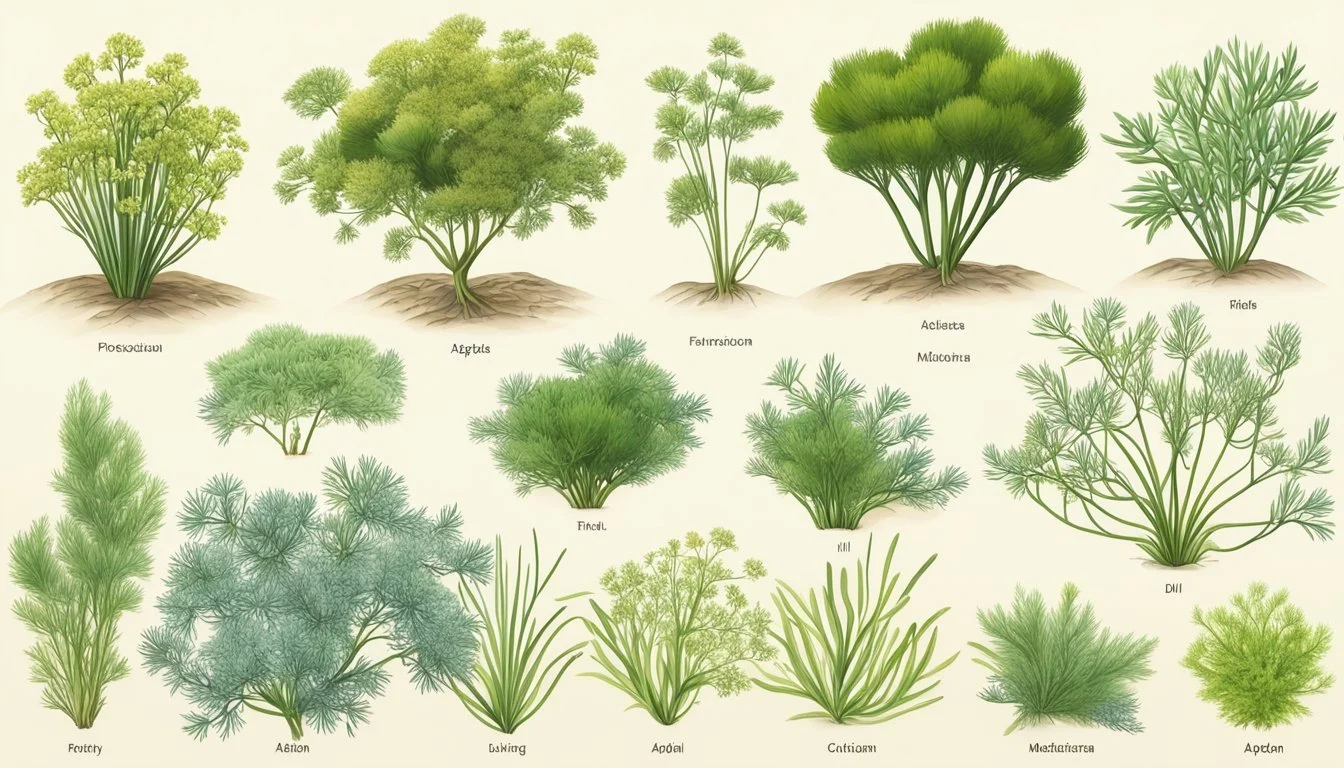How Long Does Dried Dill Last?
Shelf Life and Storage Tips
Dried dill (how long does dill last?), when properly stored, retains its quality for about 2 to 3 years. Its longevity as a kitchen staple is notable, offering both convenience and the preserving of its distinctive flavor for an extended period. Factors that contribute to the extended shelf life of dried dill include the dehydration process, which reduces moisture and thereby inhibits bacterial growth that could otherwise expedite spoilage.
Maintaining the freshness of dried dill entails storing it in containers with tight-fitting lids, away from heat, light, and moisture. These storage conditions help to preserve the herb's aromatic qualities and prevent deterioration. Over time, dried dill may lose some of its potency, requiring a larger amount to achieve the desired flavor in culinary applications, so it is important to periodically assess the quality of the herb. If signs of spoilage such as discoloration, mold, or an off aroma are present, the dried dill should be discarded for safety and quality reasons.
Understanding Dill
Dill is a widely used herb known for its unique flavor, which is why understanding both its fresh and dried forms is essential for culinary applications.
Dill Overview
Dill, scientifically known as Anethum graveolens, is an annual herb in the celery family. It is indigenous to the Mediterranean and European regions but has become popular worldwide. The herb possesses a distinct aroma and flavor profile, characterized by a slightly grassy and anise-like taste, making it quite versatile in cooking. Dill is typically used in seasoning, salads, soups, and especially pickling.
Fresh vs. Dried Dill
The choice between fresh dill and dried dill greatly affects the flavor intensity and longevity of the herb in dishes.
Fresh Dill:
Flavor: More intense and bright when compared to dried dill.
Shelf Life: Lasts about 10 to 14 days in the refrigerator when stored properly, which is notably longer than some other herbs like basil.
Dried Dill:
Flavor: Less potent than fresh but still maintains the characteristic dill flavor, making it suitable for dishes with longer cooking times.
Shelf Life: Can last up to 6 months in a dry, airtight container stored in a cool pantry or spice drawer.
In either case, dill's flavor is a key reason for its popularity, and the choice between fresh and dried depends on the desired intensity of flavor and the shelf life needed.
Drying Dill
Preserving the flavor of dill relies heavily on the method of drying. Properly dried dill can enhance dishes with its aromatic qualities long after the fresh herb has gone out of season.
Methods of Drying Dill
Oven Drying:
Preheat the oven to its lowest temperature setting.
Spread the dill leaves in a single layer on a parchment-lined baking tray.
Prop open the oven door slightly to allow moisture to escape and dry the dill for 2-4 hours.
Check every 30 minutes to prevent burning.
Microwave Drying:
Place a single layer of dill leaves between two paper towels on a microwave-safe plate.
Microwave on high power in bursts of 30 seconds to 1 minute.
After each burst, check for dryness and continue until the dill is completely dry.
Dehydrator Drying:
Spread out dill leaves on the dehydrator trays, ensuring they do not overlap.
Follow the dehydrator's instructions, typically setting it to the herb preset or around 95°F (35°C).
Check periodically until the leaves are crispy and dry.
Natural Air Drying:
Tie dill sprigs into small bunches.
Hang them upside down in a well-ventilated, dark, and dry place.
Allow to air dry for 1-2 weeks, checking for any signs of mold or decay.
Storing Fresh Dill for Drying
Before drying, one should store fresh dill properly to preserve its natural oils and flavor. Storing fresh dill involves ensuring it's dry and free from excess moisture:
Harvest dill in the morning when the natural dew has evaporated to maintain essential oils.
Rinse the dill leaves to remove dirt and pat them dry with paper towels.
Fresh dill can be lightly wrapped in paper towels and placed in a plastic bag in the refrigerator for a short time before drying.
By following these techniques, they can achieve dry dill that retains its flavor and aroma, suitable for a variety of culinary applications.
Preservation Techniques
Dried dill's longevity significantly depends on how it is stored. Understanding and applying the correct storage methods can preserve the flavor and extend the shelf life of dried dill.
Best Practices for Storing Dried Dill
When storing dried dill, it is imperative to keep it in a cool, dry place away from direct sunlight. A pantry or a kitchen cabinet can often provide the ideal conditions. Dried dill weed (how long does dried dill weed last?) should be placed in an airtight container such as a glass jar with a tight-sealing lid. This prevents moisture and air from compromising the quality and potency of the dried herb.
Use of airtight containers: A glass jar or a vacuum-sealed bag will protect dried dill from moisture and air exposure.
Selection of storage location: Store the container in a cool, dry place to prevent degradation from heat and light.
Extending the Shelf Life of Dried Dill
To maximize the lifespan of dried dill, one could also refrigerate or freeze the herb. Although these methods are typically associated with preserving fresh dill, they can further extend the life of dried dill when used appropriately.
Refrigeration: Storing in the refrigerator can help in preserving the flavor and preventing spoilage.
Freezing: For long-term storage, freezing dried dill in parchment paper-wrapped packets before placing them in freezer bags can be effective.
When choosing to refrigerate or freeze, ensuring no moisture enters the container is critical, as it could lead to mold growth. A salad spinner can be used before preservation methods to remove excess moisture from fresh dill, helping to enhance its longevity when dried and stored properly.
Recognizing Spoilage
When assessing the condition of dried dill, one should look for signs of spoilage that indicate the herb is no longer suitable for use. The presence of mold is a clear indicator that the dried dill has been compromised. Mold can appear as fuzzy spots in various colors, such as white, green, or black. It not only renders the herb unsafe for consumption but can also cause it to emit an unpleasant odor.
To ascertain if dried dill has spoiled, one may also observe changes in texture and appearance. Healthy dried dill should be somewhat crumbly when crushed between fingers, signifying it has been appropriately dried. However, if it feels soggy or clumps together, moisture may have entered the storage container, leading to potential spoilage.
Key Signs of Spoilage:
Presence of Mold: Any visible mold growth is a sure sign of spoilage.
Unusual Odor: A musty or off smell is a red flag.
Altered Appearance: Discoloration or damp spots indicate spoilage.
It's crucial to perform regular checks on stored dried dill, especially if stored in conditions that may promote mold growth, such as areas with high humidity or fluctuating temperatures. If one suspects the dill has spoiled, they should discard it immediately to avoid the risk of foodborne illness. Remember, when in doubt, it's always safer to discard the herb rather than risk consuming a contaminated product.
Culinary Uses
Dried dill is a versatile ingredient that plays a pivotal role in a variety of recipes, enhancing flavors with its distinct taste and aroma.
Using Dried Dill in Recipes
Soups & Stews: Chefs often incorporate dried dill into soups and stews to add a slightly sweet and grassy flavor. Its presence can complement the savoriness of broths and the richness of cream-based soups.
Pickles: A traditional use for dried dill is in pickling. Its essential oils contribute to the classic dill pickle taste which is a balance of sour and herbal notes.
Eggs & Potatoes: Dried dill pairs excellently with eggs, adding complexity to dishes like scrambled eggs or an omelet. When tossed with roasted or boiled potatoes, it imparts a refreshing flavor.
Fish & Seafood: A staple in seafood cooking, dried dill works well with fish, particularly salmon. It's used to season fish before grilling or baking and in sauces accompanying the seafood.
Vegetables: Steamed or sautéed vegetables are often seasoned with dried dill. It complements the natural flavors of carrots, cucumbers, and zucchini.
Tea: Dill seeds, not the weed, are sometimes used to make dill tea, which is believed to have digestive benefits.
Baking: In some cuisines, dried dill is an ingredient in bread dough, where it adds its signature taste to the baked goods.
Global Cuisines: Dried dill is utilized in various cuisines worldwide, from Scandinavian to Mediterranean dishes, showcasing its universal appeal as a flavor enhancer.
Health and Nutrition
Dried dill is recognized not only for its culinary use but also for its nutritional value. It retains many of the vitamins and minerals found in fresh dill, albeit in lesser amounts due to the drying process. Consuming dried dill can contribute to one's daily intake of:
Vitamins: It provides vitamin C, vitamin A, and several B-vitamins, such as folic acid and vitamin B6. These vitamins are crucial for immune function, vision health, and energy metabolism.
Minerals: Dried dill contains minerals like calcium for bone health, iron for blood cell formation, and magnesium for nerve and muscle function.
Essential Oils in Dried Dill:
The essential oil content in dried dill contributes to its distinctive aroma and beneficial properties. These oils are thought to have antioxidant effects and may support digestion.
Dried Dill's Nutrient Content:
Below is a concise table summarizing key nutrients found in dried dill:
Nutrient Why It's Beneficial Vitamin C Antioxidant; supports immune system Vitamin A Vision health; immune function Folic Acid Cell growth; maternal health Calcium Bone strength and development Iron Essential for red blood cell production Magnesium Regulates muscle and nerve functions
While dried dill offers these nutrients, it should be incorporated as part of a balanced diet to help ensure adequate nutrition.
Practical Tips
In preserving the potency of dill, effective harvesting and proper drying methods are key. Following these practical steps ensures that dried dill retains its flavor for an extended period.
Harvesting and Preparing Dill for Drying
It's crucial to harvest dill at the right time, ideally just before it flowers when its essential oils are at their peak. Using scissors, one should cut the sprigs in the morning when their moisture levels are low. They must be clean; therefore, it's recommended to wash them gently and pat them dry with paper towels.
Steps to prepare dill for air drying:
Group Sprigs: Bundling 4-5 sprigs together is optimal.
Secure Bundles: Tie each dill bundle with rubber bands to account for shrinking stems as they dry.
Protect From Dust: Encase the bundles in paper bags with holes, ensuring air circulation.
Hang to Dry: Choose a warm, dry place out of direct sunlight to hang the bundles upside down.
Alternative Methods for Preserving Dill
While air drying is popular, other methods like using a dehydrator, or freezing can be equally effective.
Dehydrator: To preserve the dill's natural oils, dry at a low temperature around 95°F (35°C).
Freezing: For those with a limited space, freezing dill sprigs in airtight containers or zipped bags is a practical solution.
Preserving dill using these methods allows for long-term storage while maintaining its flavor, reminiscent of a summer garden harvest.
Understanding Longevity
The shelf life of dried dill is a key consideration for culinary enthusiasts and home cooks aiming to preserve its aromatic qualities. Dried dill typically lasts from 2 to 3 years when stored properly. The longevity of dried dill can be attributed to the reduction of moisture content, which inhibits the growth of microorganisms that cause spoilage.
To ensure maximum shelf life, dried dill should be stored in containers with tight-fitting lids. This method of storage helps retain the herb's potency and aroma.
Here are factors that affect the longevity and quality of dried dill:
Moisture: The presence of moisture can lead to mold growth and spoilage.
Light: Long exposure to light can degrade the quality of the dill, leading to a loss of aroma.
Temperature: A cool environment is ideal as heat can cause the herbs to lose their flavor more quickly.
Storage Condition Effect on Longevity Airtight container Extends the shelf life Cool temperature Preserves flavor and aroma Dry environment Prevents mold and spoilage
In terms of potency, the aromatic compounds in dill may diminish over time, but dill that has been dried tends to have a stronger flavor per volume when compared to its fresh counterpart. Consequently, the dried herb should be used in smaller quantities to avoid overpowering a dish.
Dill Substitutes
When a recipe calls for dill, and it is not on hand, one has several substitute options to consider. Below is a list of alternatives that can replace dill effectively, depending on the recipe's requirements:
Dried Dill: For every tablespoon of fresh dill, one can use one teaspoon of dried dill as they are directly interchangeable in recipes.
Fresh Dill Dried Dill Substitute 1 tbsp 1 tsp
Fennel Fronds: Fennel (how long does fennel last?) has a texture similar to dill, though with a slight aniseed flavor. They act as an excellent garnish substitute.
Fresh Dill Fennel Fronds Substitute 1 tbsp 1 tbsp
Fresh Tarragon: With a hint of licorice, tarragon can replace dill and works well in sauces and dressings.
Fresh Dill Fresh Tarragon Substitute 1 tbsp 1 tbsp
Parsley: For a mild flavor and similar appearance, parsley is a good choice, especially as a garnish.
Fresh Dill Parsley Substitute 1 tbsp 1 tbsp
Basil: While basil has a distinct flavor profile, it can work in some dishes requiring dill, especially in Mediterranean cuisine.
Fresh Dill Basil Substitute 1 tbsp 1 tbsp
One should consider the distinctive flavors of these substitutes and how they will interact with other ingredients in the dish. Also, the ratios may vary slightly depending on the specific taste preferences and the potency of the herbs.
DIY Drying Equipment
When preserving the delicate flavor of dill, utilizing the right drying equipment is essential. There are multiple DIY methods that can be employed for drying dill effectively without the necessity of purchasing a food dehydrator.
Air Drying Technique: A time-honored method is air drying, where one simply ties bundles of dill and hangs them in a well-ventilated, dry area away from direct sunlight. It's crucial to ensure good air circulation to prevent mold. This method usually takes one to two weeks.
Oven Drying: For a quicker process, a conventional oven can be employed. Line a baking sheet with parchment paper, spread the dill evenly, and set the oven to the lowest possible temperature. The oven door should remain slightly open to allow moisture to escape.
Microwave Drying: In cases where time is of the essence, a microwave can serve as an expedient drying tool. Place dill between two paper towels on a microwave-safe plate and use the defrost setting in short intervals until the dill is completely dry.
Using Paper Bags: Small bundles of dill can be placed inside paper bags with several holes for air circulation and hung up. This method protects the dill from light and dust and can work well for drying seeds.
Regardless of the method chosen, the final step involves storing the dried dill in an opaque and dry container. This helps maintain its flavor, making it ready for use in various dishes, like seafood, where its distinct taste is most celebrated. It's important that the containers are kept in a cool, dry place to maximize the dill's shelf life.
Maximizing Aroma and Flavor
Preserving the distinct aroma and flavor of dried dill is essential for enhancing the taste of various dishes. One can achieve this by following proper storage techniques and handling methods.
Storage Containers:
To retain dill's aroma and flavor, store the herb in airtight containers.
Glass jars with tight-fitting lids are ideal.
Location:
Choose a cool, dark place away from direct sunlight.
Cabinets or pantries provide the perfect environment, preventing degradation of essential oils.
Humidity Control: Emphasis on Tea Bag Trick
Small packets of silica gel can be added to the containers, or a tea bag can be placed alongside the dried dill to absorb excess moisture.
Usage:
Before adding to dishes like salads or tea blends, crush the leaves gently to release the flavors. This is where a salad spinner can serve a dual purpose; it not only helps in drying fresh dill after washing but can also be used for a quick gentle toss of dried dill to awaken its aroma before use.
Avoid Moisture:
Ensuring hands and utensils are dry before contact with dried dill is pivotal; moisture can compromise quality.
By closely managing these aspects, one preserves the integrity of the dried dill's aroma and flavor, thereby extending its shelf life and culinary impact.
Dill in Different Cultures
Dill is a herb that features prominently in various cuisines around the world, each culture incorporating it in unique ways that often reflect regional tastes and culinary traditions.
European Cuisine: In Scandinavian countries, dill is a key player in a variety of dishes, especially those involving fish. It's not uncommon to find gravlax, a Nordic dish where salmon is cured with dill, sugar, and salt. In this region, dill is revered for its ability to enhance the delicate flavors of seafood.
Middle Eastern Flavors: Countries in the Middle East incorporate dill in their cuisine quite differently. It is woven into rice dishes, used in savory pastries, and added to yogurts to create refreshing dips.
Russian and Eastern European Dishes: Dill is vital in Russian and Eastern European culinary practices; it punctuates the flavors of soups such as borscht. Additionally, it is a common herb in the pickling process, granting a distinctive taste to a variety of pickled vegetables. (What wine goes well with pickled vegetables?)
Region Common Dill Usage Mediterranean Mixed into tzatziki, a yogurt-based cucumber dip South Asia Added to curries and lentil dishes for aromatic undertones
As a widely used herb, dill brings not only unique flavors but also a degree of cultural authenticity to dishes. Its versatility ensures it has a place in kitchens worldwide, enhancing everything from creamy sauces to robust meat dishes with its fresh, slightly anise-like flavor.
Frequently Asked Questions
When it comes to preserving dill, understanding the lifespan and storage techniques of dried dill ensures that one can enjoy its flavor for as long as possible.
Common Concerns About Dried Dill
How long does dried dill last?
Dried dill, when stored properly, can last up to 1 to 3 years. It's crucial to store it in an airtight container and place it in a cool, dark environment to maintain its quality and flavor.
How to dry dill?
Dill can be dried using several methods, such as air drying, using a dehydrator, or the oven. For oven drying, one should set their oven to the lowest temperature, generally between 225°F and 270°F, and spread the dill evenly on parchment paper until dry.
How to store dried dill?
To store dried dill:
Use an airtight container to protect it from moisture and other contaminants.
Keep the container in a cool, dark place like a pantry or cupboard, away from direct sunlight.
Ensure the dill is completely dry before storing to prevent mold growth.



